The Intel Core Ultra 7 155H Review: Meteor Lake Marks A Fresh Start To Mobile CPUs
by Gavin Bonshor on April 11, 2024 8:30 AM ESTASUS Zenbook 14 OLED UX3405MA: AI Performance
As technology progresses at a breakneck pace, so do the demands of modern applications and workloads. As artificial intelligence (AI) and machine learning (ML) become increasingly intertwined with our daily computational tasks, it's paramount that our reviews evolve in tandem. To this end, we have AI and inferencing benchmarks in our CPU test suite for 2024.
Traditionally, CPU benchmarks have focused on various tasks, from arithmetic calculations to multimedia processing. However, with AI algorithms now driving features within some applications, from voice recognition to real-time data analysis, it's crucial to understand how modern processors handle these specific workloads. This is where our newly incorporated benchmarks come into play.
Given makers such as AMD with Ryzen AI and Intel with their Meteor Lake mobile platform feature AI-driven hardware, aptly named Intel AI Boost within the silicon, AI, and inferencing benchmarks will be a mainstay in our test suite as we go further into 2024 and beyond.
The Intel Core Ultra 7 155H includes the dedicated Neural Processing Unit (NPU) embedded within the SoC tile, which is capable of providing up to 11 TeraOPS (TOPS) of matrix math computational throughput. You can find more architectural information on Intel's NPU in our Meteor Lake architectural deep dive. While both AMD and Intel's implementation of AI engines within their Phoenix and Meteor Lake architectures is much simpler than true AI inferencing hardware, these NPUs are more designed to provide a high efficiency processor for handling light-to-modest AI workloads, rather than a boost to overall inferencing performance. For all of these mobile chips, the GPU is typically the next step up for truly heavy AI workloads that need maximum performance.
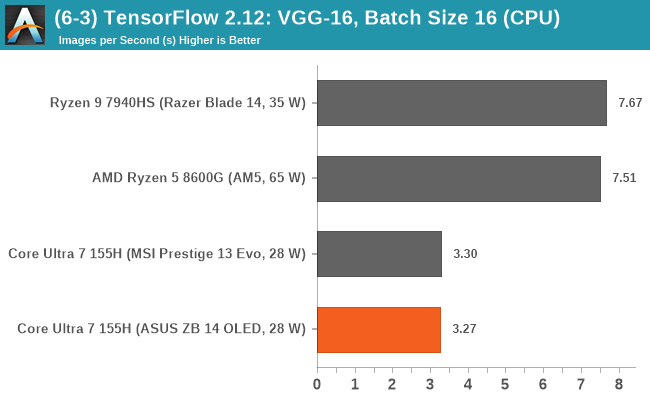
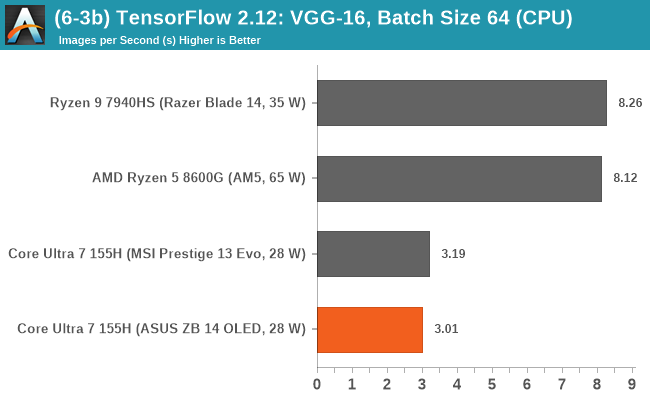
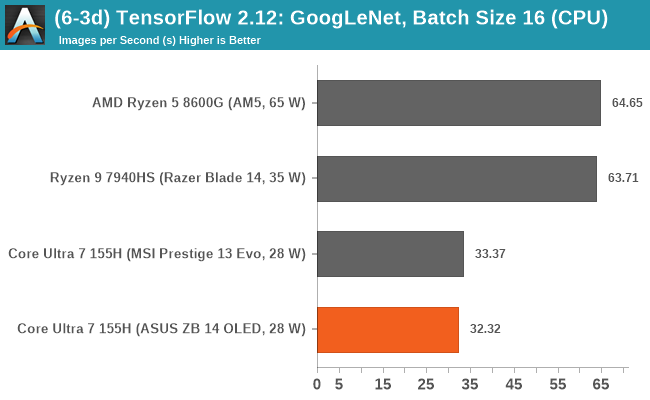
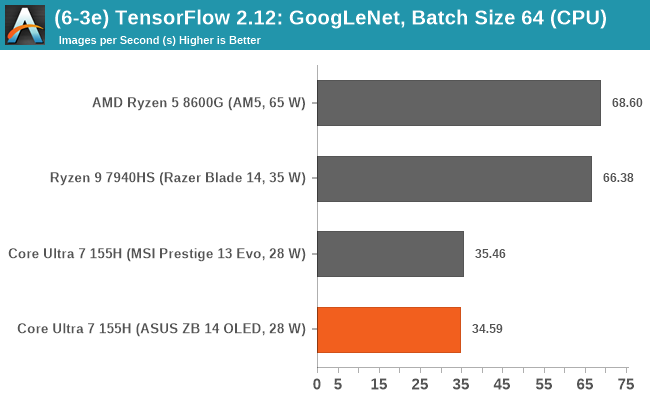

Looking at performance in our typical TensorFlow 2.12 inferencing benchmarks from our CPU suite, using both the VGG-16 and GoogLeNet models, we can see that the Intel Core Ultra 7 155H is no match for any of the AMD Phoenix-based chips.
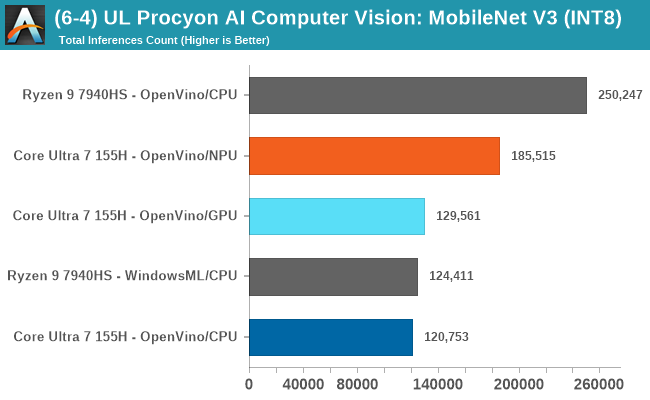
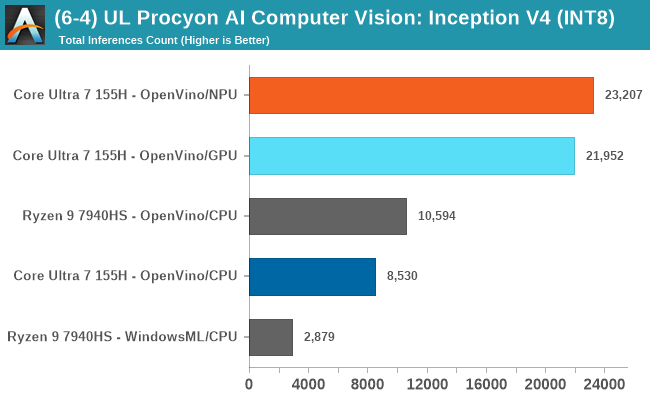

Meanwhile, looking at inference performance on the hardware actually optimized for it – NPUs, and to a lesser extent, GPUs – UL's Procyon Computer Vision benchmark collection offers support for multiple execution backends, allowing it to be run on CPUs, GPUs, or NPUs. For Intel chips we're using the Intel OpenVINO backend, which enables access to Intel's NPU. Meanwhile AMD does not offer a custom execution backend for this test, so while Windows ML is available as a fallback option to access the CPU and the GPU, it does not have access to AMD's NPU.
With Meteor Lake's NPU active and running the INT8 version of the Procyon Computer Vision benchmarks, in Inception V4 and ResNet 50 we saw good gains in AI inferencing performance compared to using the CPU only. The Meteor Lake Arc Xe LPG graphics also did well, although the NPU is designed to be more power efficient with these workloads, and more often as not significantly outperforms the GPU at the same time.
This is just one test in a growing universe of NPU-accelerated appliations. But it helps to illustrate why hardware manufactuers are so interested in NPUs: they deliver a lot of performance for the power, at least as long as a workload is restricted enough that it can be run on an NPU.
That all being said, even with the dedicated Intel AI Boost NPU within the SoC tile, the use case is very specific. Even trying generative AI within Adobe Photoshop using Neural fillers, Adobe was relying much more on the CPU than it was the GPU or the NPU, which shows that just because it's related to generative AI or inferencing, the NPU isn't always guaranteed to be used. This is still the very early days of NPUs, and even just benchmarking them for an active task remains an interesting challenge.


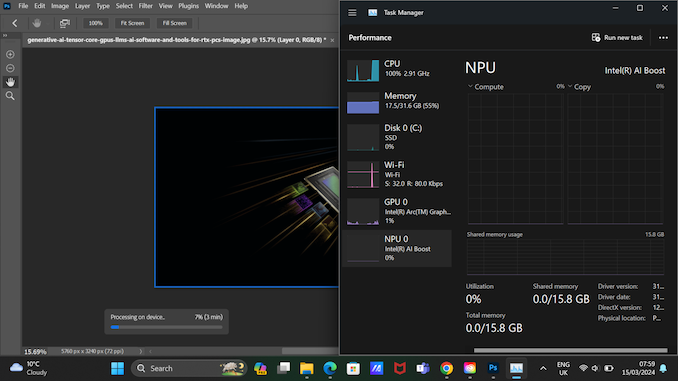








69 Comments
View All Comments
Ryan Smith - Thursday, April 11, 2024 - link
"Also the official title is CPU review and there are graphs for BATTERY CHARGE TIME ??? Really ? What does that have to do with the CPU at all ?"With these integrated devices, we're reviewing the notebook as much as we're reviewing the chip inside. And in any case, battery life/recharge testing is very straightforward and is something that can be run overnight, so it doesn't get in the way of other testing. Reply
haplo602 - Friday, April 12, 2024 - link
Sure, but then the title should be "Review of 155H and the ASUS Zenbook 14". If it is a CPU review, then the other tests are irrelevant. If it is a device review, then there are things missing.Currently it poses as a some kind of strange hybrid while the title says only CPU review. Basically the content does not match the label on the box ... Reply
mode_13h - Monday, April 15, 2024 - link
> Intel has a huge advantage with LPDDR5X here that it manages to waste somehow.LPDDR5 and 5X are both much higher-latency than regular DDR5. That probably explains some of the performance vs. expectations mismatch. Reply
timecop1818 - Thursday, April 11, 2024 - link
what's with the trend of removing INS key and replacing it with a camera or power or some other useless button. this is getting ridiculous. i use shift-ins to paste all the time, and there are plenty of times when i want to overwrite something without caring to select it, thus needing an ins toggle. what the hell? is this some new crap mandated by the Microsoft ai button initiative? Replysylwah - Thursday, April 11, 2024 - link
From the inconsistencies between benchmark results and the text, to the comparison between latest Intel and previous gen AMD and the article title, this is clearly paid advertising by either Asus or Intel.Journalism guidelines say paid content should be disclosed, and yet I see it nowhere in the article. Feels like a new low. Reply
Orfosaurio - Thursday, April 11, 2024 - link
Maybe, but there is the presumption of innocence. ReplyRyan Smith - Friday, April 12, 2024 - link
"this is clearly paid advertising by either Asus or Intel."This is not a paid article in any shape or form. We have not received a dime from any party for this review.
To be clear, Intel did supply the Asus laptop for review purposes - as they usually do for mobile-first CPU launches - and we sourced the MSI laptop separately so that we could have a second data point. Reply
jeenam - Friday, April 12, 2024 - link
The benchmarks don't paint the Intel chip in a positive light. I agree with your assessment. The first thing I checked was the Graphics benchmarks as I recently purchased a 7840HS which has the Radeon 780M iGPU. It would seem Company of Heroes and Returnal were cherry-picked for the GPU benchmarks just so it would appear the integrated Intel ARC GPU isn't a dog compared to the 780M.Any objective reader who simply went on benchmarks would make the following honest assessment:
- The Intel ARC GPU is a dog compared to the 780M
- General benchmark performance indicates the Intel chip getting smoked by Ryzen 4
- The one area where Intel has an advantage is battery life
It's obvious the GPU benchmarks included games that were cherry-picked to give the appearance that the Intel ARC GPU can actually be competitive, when most likely if you were to pick a typical suite of games for benchmarking (e.g. GTA V, RE4 Remake, Forza, CS2, etc.) the losses to the 780M would continue to pile up. Reply
Ryan Smith - Friday, April 12, 2024 - link
" It would seem Company of Heroes and Returnal were cherry-picked for the GPU benchmarks just so it would appear the integrated Intel ARC GPU isn't a dog compared to the 780M."To be clear, the benchmarks were picked before we had the hardware. There's a lot of calculus that goes into selecting software for the benchmark suite, but the big things are suitability as a benchmark (i.e. does it even have a benchmark mode), popularity, and performance scalability.
Even then, we kind of whiffed it in the end, as Returnal doesn't break 30fps on current iGPUs. Reply
Hulk - Friday, April 12, 2024 - link
It's a great review and I appreciate it. Reply